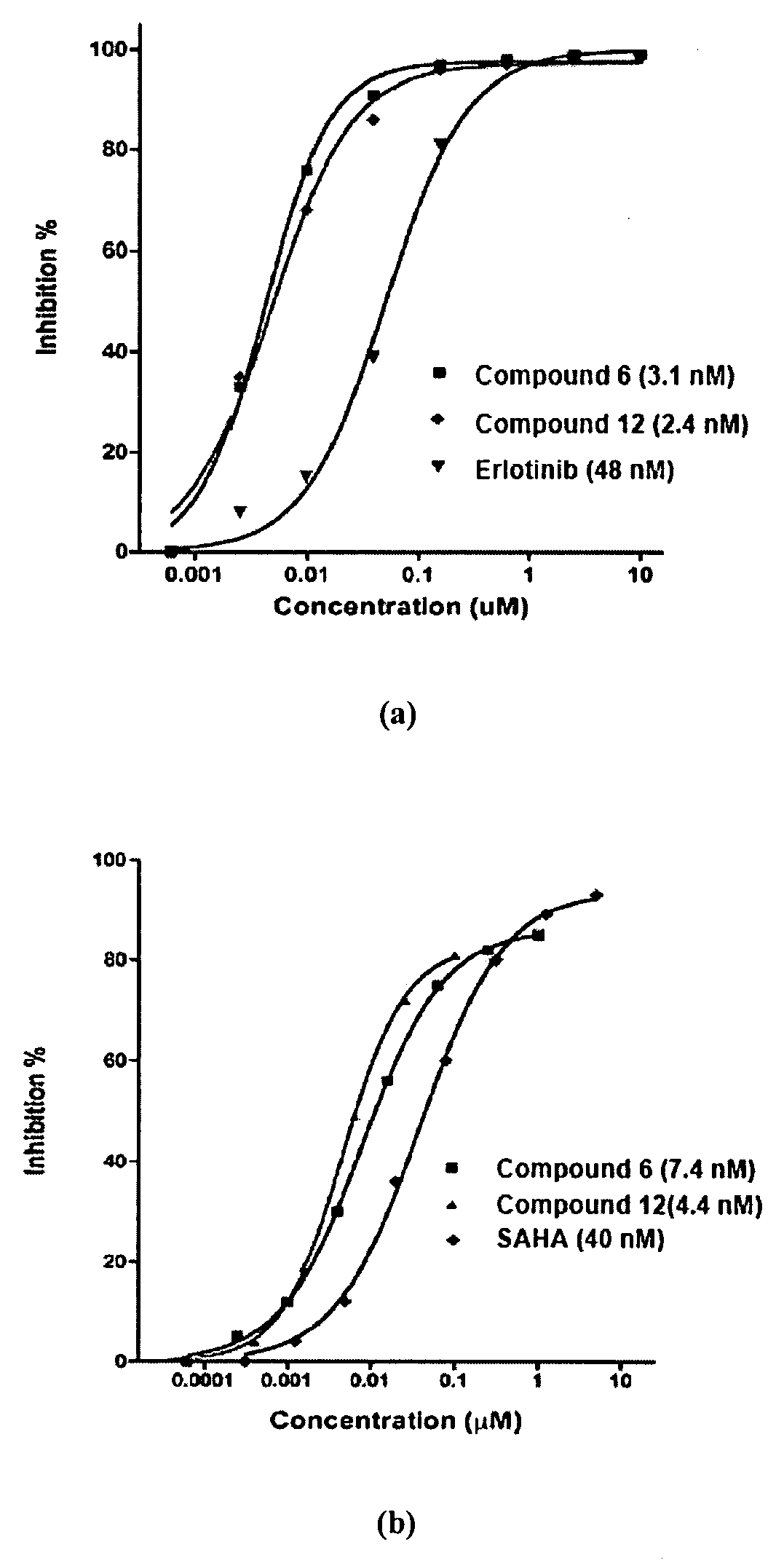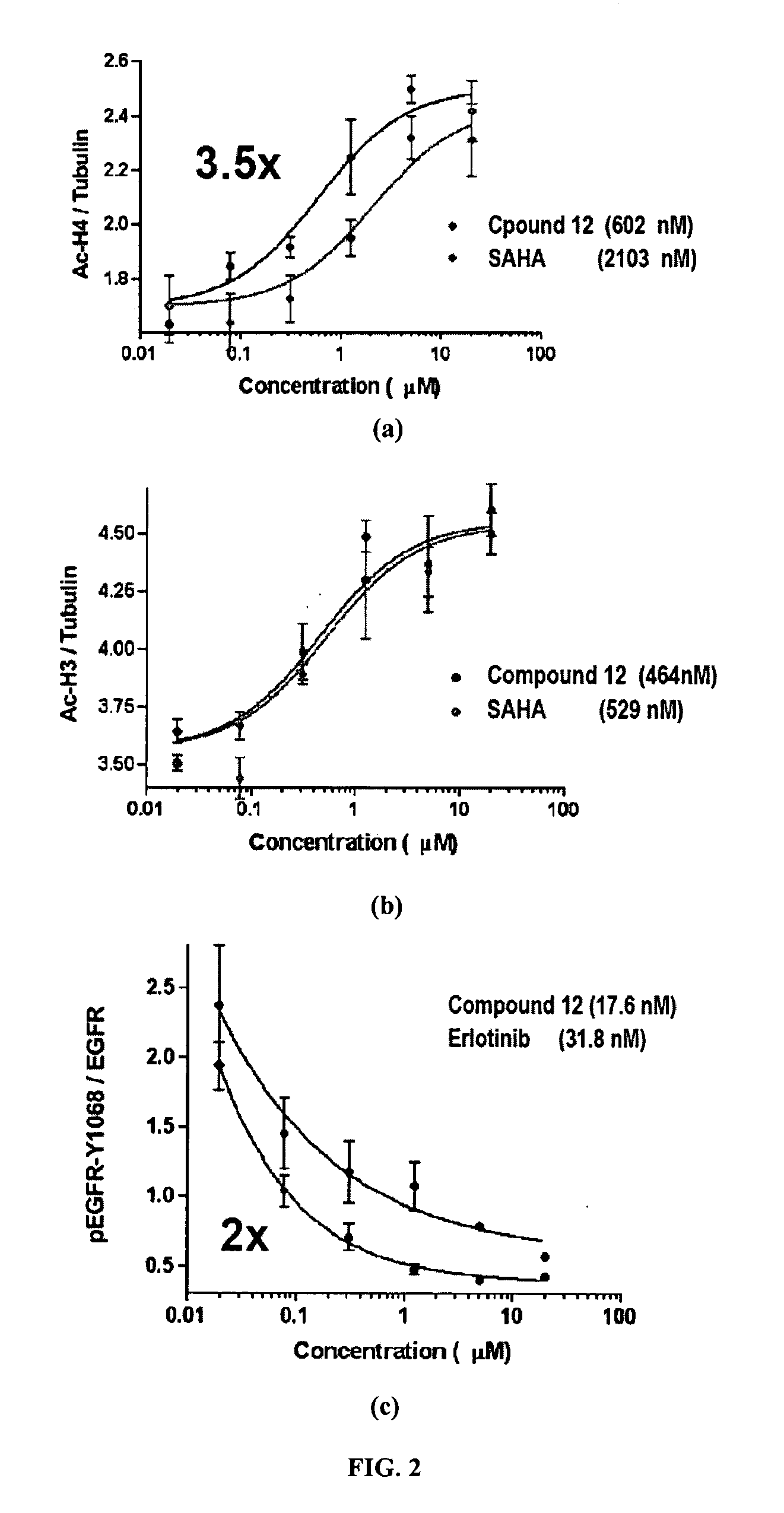Multi-Functional Small Molecules as Anti-Proliferative Agents
a multi-functional, anti-proliferative technology, applied in the direction of biocide, drug composition, immunological disorders, etc., can solve the problems of limited ability to use such combinations, and high regulatory requirements for demonstrating safety and efficacy of combination therapies. , to achieve the effect of improving activity
- Summary
- Abstract
- Description
- Claims
- Application Information
AI Technical Summary
Benefits of technology
Problems solved by technology
Method used
Image
Examples
example 43
Preparation of 7-(4-(3-bromobenzylamino)-7-methoxyquinazolin-6-yloxy)-N-hydroxyheptanamide (Compound 89)
Step 43a. 4-(3-Bromobenzylamino)-7-methoxyquinazolin-6-ol (Compound 0701-89)
[0456]The title compound 0701-89 was prepared as a yellow solid (543 mg, 50.2%) from compound 0105 (750 mg, 3.0 mmol) and (3-bromophenyl)methanamine (1674 mg, 9 mmol) using a procedure similar to that described for compound 0701-77 (Example 32): LCMS: 360 [M+1]+.
Step 43b. Ethyl 7-(4-(3-bromobenzylamino)-7-methoxyquinazolin-6-yloxy)heptanoate (Compound 0702-89)
[0457]The title compound 0702-89 was prepared as a yellow solid (230 mg, 89.15%) from compound 0701-89 (180 mg, 0.5 mmol), ethyl 7-bromoheptanoate (120 mg, 0.5 mmol) using a procedure similar to that described for compound 0702-77 (Example 32): LCMS: 516 [M+1].
Step 43c. 7-(4-(3-bromobenzylamino)-7-methoxyquinazolin-6-yloxy)-N-hydroxyheptanamide (Compound 89)
[0458]The title compound 89 was prepared as a white solid (105 mg, 53.96%) from compound 0702-8...
example 44
Preparation of 4-(2-(4-(3-chloro-4-fluorophenylamino)-7-methoxyquinazolin-6-yloxy)ethoxy)-N-hydroxybenzamide (Compound 92)
Step 44a. Methyl 4-(2-bromoethoxy)benzoate (Compound 0502-92)
[0459]A mixture of compound 4-hydroxybenzoic acid methyl ester (457.0 mg, 3.0 mmol), K2CO3 (828 mg, 6 mmol) and 1,2-dibromoethane (10 mL) was heated at 130° C. for 8 h. The 1,2-dibromoethane was removed under reduced pressure and the residue was suspended in water. The resulting precipitate was isolated and dried to give the title compound 0502-92 as a white solid (440 mg, 57%). LCMS: 259 [M+1].
Step 44b. Methyl 4-(2-(4-(3-chloro-4-fluorophenylamino)-7-methoxyquinazolin-6-yloxy)ethoxy)benzoate (Compound 0503-92)
[0460]A mixture of compound 109 (384 mg, 1.2 mmol), K2CO3 (276 mg, 2 mmol), compound 0502-92 (311 mg, 1.2 mmol) and DMF (10 mL) was heated at 40° C. overnight. The DMF was removed under reduced pressure and the residue was suspended in water. The precipitate was collected and dried to give the tit...
example 45
Preparation of 7-(4-(3-ethynylphenylamino)-7-methoxyquinazolin-6-yloxy)-N-methoxyheptanamide (Compound 95)
[0462]A mixture of compound 0802 (544 mg, 1.25 mmol) and Inodomethane (0804) (177 mg, 1.25 mmol) and potassium carbonate (1.0 g, 7.25 mmol) in N,N-dimethylformamide (15 mL) was stirred at room temperature for 12 hours. The solvent was removed under reduce pressure and the residue was dissolved in ethyl acetate (50 mL). The organic layer was washed with saturation aqueous NaHCO3 (20 mL) and brine (20 mL). The organic layer was dried over MgSO4 and concentrated to give the title compound 95 as pale yellow solid (500 mg, 89%). m.p. 195.8˜197.0° C.; LCMS: 449 [M+1]+; 1H NMR (DMSO-d6); δ 1.35 (m, 2H), 1.50 (m, 4H), 1.80 (m, 2H), 1.94 (t, J=7.2 Hz, 2H), 3.54 (s, 3H), 3.92 (s, 3H), 4.12 (t, J=6.3 Hz, 2H), 4.19 (s, 1H), 7.19 (m, 2H), 7.40 (t, J=7.8 Hz, 1H), 7.80 (s, 1H), 7.87 (d, J=9.6 Hz, 1H), 7.97 (s, 1H), 8.48 (s, 1H), 9.45 (s, 1H), 10.92 (s, 1H).
PUM
 Login to View More
Login to View More Abstract
Description
Claims
Application Information
 Login to View More
Login to View More - R&D
- Intellectual Property
- Life Sciences
- Materials
- Tech Scout
- Unparalleled Data Quality
- Higher Quality Content
- 60% Fewer Hallucinations
Browse by: Latest US Patents, China's latest patents, Technical Efficacy Thesaurus, Application Domain, Technology Topic, Popular Technical Reports.
© 2025 PatSnap. All rights reserved.Legal|Privacy policy|Modern Slavery Act Transparency Statement|Sitemap|About US| Contact US: help@patsnap.com



